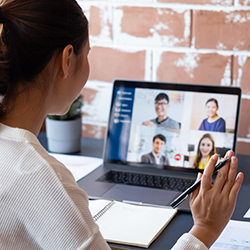


Cybersecurity strategies for working from home
In 2020, Malwarebytes surveyed IT and cybersecurity leaders about whether their companies were prepared for remote work during the coronavirus pandemic. Forty-five percent of those respondents said that devices being more exposed at home, where non-employees may have access and inadvertently compromise those devices, was their biggest cybersecurity concern. So how can you make sure you’re keeping your laptop and other devices safe at home?
- Antivirus and internet security software that helps prevent malware, spyware and other attacks
- Operating system and software updates to provide the most current patches that fix bugs and security gaps
- A secure VPN to safely share information across shared or public networks – like your home WiFi – as if you were connected directly to your employer’s private network
- Centralized storage or cloud access for backing up documents

Second, make sure your WiFi router is secure. If you’re still using the default password that came with the router, change it to something unique and hard to guess now. While you’re in there changing the password, update the name of your network, or SSID, too. Choose something that can’t be traced back to your home.
Enable network encryption, too. There are a few methods available, but WPA2 is the strongest. You can change this through the WiFi settings on your router’s management page.
Not only is securing your WiFi good for protecting your work data, but it also helps protect anything else you have on your network. Alexa, your smart TV, personal tablets – any device connected to the Internet of Things – is more secure when your router is password protected and encrypted.
Perhaps the best line of defense against breaches in cybersecurity is you, not all the malware software and password managers and whatnot. Take the time to learn about phishing and email scams. Know how to identify them and report them to your employer.
Safe sightlines for remote work
You also want to keep prying eyes away from sensitive or confidential documents. With the rise in videoconferencing, be aware of what you’re screensharing. There may be “for your eyes only” information in a document without you thinking about it. You don’t want to flash that up for everyone on your Zoom meeting to see.
On a similar note, invest in a sliding webcam cover. While it doesn’t affect what others can see on your screen, it can help keep them from peeping something around your home office they shouldn’t. It could be a physical copy of an important document on your desk, or it could simply be a family photo in the background you’d rather not share with coworkers or third-party vendors.
Securing your home office
What if the prying eyes are in your own home? We doubt your family is trying to steal sensitive information, but you still need to take extra steps to keep them away from work devices and documents. Lock your computer and phone when you step away from your desk. Better yet, turn on the automatic locking function.
Don’t let your kids or others use your work devices and be diligent about keeping work-related materials off personal devices. At best, it’s embarrassing if your kiddo accidentally emails your boss. But worst-case scenario, they send confidential information to someone or delete it altogether.
If you need to keep a closer eye on who enters your home office, consider a secure lock on the door. Typically, we think of deadbolts and smart locks for the front door and other exterior entrances. But an electronic lock like the Schlage Touch® Keyless Touchscreen Lever or Schlage keypad lever is ideal for a home office that requires an extra level of security.
Finally, whether it’s for your keypad lock, phone or computer, set secure passwords. Check out this article for how to create secure access codes.

Sound privacy when you work from home
When we talk about white noise machines for the home, it’s usually as a way to get better sleep. They work great for home offices, too, though. If you want to keep others from hearing your phone calls, try a device like the Sound+Sleep. It has 10 audio programs to fit any kind of work mood you’re in and dynamically adjusts the volume based on other noises in the room.
Other ways to control sound in your home office are improved insulation, soundboards to keep noise from traveling through the walls and rugs or carpets. You might find that white noise machines and sound dampeners not only improve privacy but help you focus as well.
Just because you’re working remotely doesn’t mean that your home shouldn’t still feel like a haven. In fact, it’s probably even more important to make your home comfortable when you spend so much time there. Get more tips for working from home at the Schlage blog. Once you’ve created your home office, you might check out our 10 WFH upgrades or learn more about how to move your home office outdoors.
Unlock more ideas
Never miss a beat - get the latest product updates, style tips and DIY tutorials sent right to your inbox.








